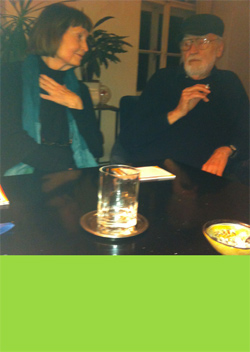I observed a dramatic proliferation of the use of participative, open creative processes in the production of artistic works in recent years. Artists who did so considered this possibility a new source of inspiration for their creative processes that previously had often been hermetically sealed off from outside influences, and sought out communication and experimentation involving others—complete strangers and acquaintances alike. Moreover, I observed that such participative works have gained favor among government bodies that commission artworks (e.g. municipal agencies) as well as among private firms and cultural institutions, which have come to regard the involvement of lots of people (e.g. local citizens, existing & prospective customers, the cultural community) as a means of enhancing their public image and are not necessarily interested in the work of art itself or the person who created it. Unfortunately, I also observed a rather uncritical, romanticized attitude on the part of artists who, psyched up by the possibilities of a communally engendered work of art, correspondingly scaled back their claims to artistic excellence.
According to Susanne Jaschko and Lucas Evers’ “el proceso como paradigma / process as paradigm” exhibition (2010) and their statement in the accompanying catalog, two factors are responsible for the fact that, today, access to and participation in works of art is on the rise: on one hand, the art system has been destabilized by the absence of structures with respect to authorship as well as simple structures with respect to copyright; on the other hand, a general shift from passive partaker to “involved agent” is evident throughout the art world.[1]
In connection with these two key phenomena, I’d like to bring in a technological factor. Its historical background: the personal computer becoming a “home appliance” in the 1980s, and then the link-up of a multitude of computers via the internet in the 1990s. Most recently, participative possibilities were facilitated by the advent of Web 2.0 in the early 21st century, as well as by the Smartphones that we constantly carry around with us. Such devices—equipped with a camera, video & sound recorder and a keyboard—make collaborative forms of communication and work readily accessible by the general populace.
In my preliminary research on this subject, I basically sought out artistic projects having to do with online participation. In my initial selection, I limited myself on the basis of neither the type of participation nor the form of the process or the result of the project.
I recognized that the questions “How does participation proceed?” and “How do participants create?” can help me to differentiate among and classify the projects. In a first phase, I realized that the following classification might help me in structuring the collected projects. (Since I’m still in the process of working out the classification terminology, I would be very grateful to receive insights and suggestions!)
ACTIVE PARTICIPATION > Crowd Creation Projects, Crowd Collection Projects, Break Free Projects
PASSIVE PARTICIPATION > Crowd Attendance (intentional or unintentional)
Crowd Creation Projects are those artistic projects and processes that the artist can influence only partially. Artists are initiators; they launch a process with numerous actively participating persons who react to each other in linear fashion in the creation process. What comes about is a work that proceeds along a trajectory of its own and is more or less out of the artist’s control. The participating individuals build upon the creations of their predecessors and modify prior changes over and over again.
Crowd Collection Projects entail a form of participation in which the artist sends out a request for contributions addressed to a (specific or indefinite) number of people, and then forms the many contributions received into a work of art. The producer of such a work of art is a collector of such things as images, videos, drawings, sound files, texts and objects. In a further step, he/she assembles the submitted fragments into a work, whereby the work of art that emerges in this way is under his/her control.
Break Free Projects are those artistic projects and processes that are created by artists as full-fledged works of art, and that are then taken and used by (lots of) others. The artistic work is discovered by the group of people carrying out the particular project and even modified/developed further. The artist can exert only a limited influence on the artistic work that has “broken free” in this way.
Crowd Attendance Projects can be divided into two basic categories that entail either the intentional or unintentional presence of human beings. On one hand, these are works of art in which the act of creation (as commonly understood) has been concluded, but the work of art does not actually “come alive” until persons (in the sense of members of an audience) cause the work to become operational through their conscious, volitional presence. This category includes, in my opinion, all interactive artworks. On the other hand, there exist works of art that entail interaction with large numbers of people who are not even aware that such interaction is occurring but are nevertheless making a contribution to a work of art of which they have no knowledge.
[1] Catalogue of the exhibition „process as paradigm“ at LABoral Centro de Arte y Créacion Industrial, Gijón; The exhibition was running from April 23rd until August 30th 2010.

